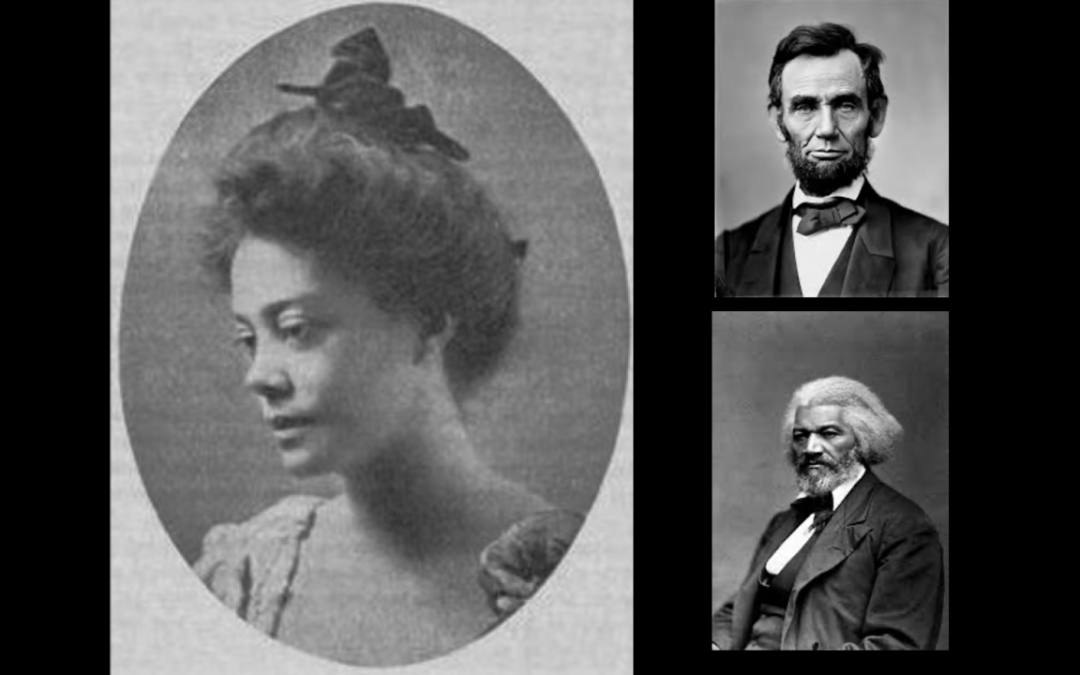by
_____
On this day in 1917, Alice Dunbar Nelson stepped up to a church pulpit in Harrisburg, Pennsylvania to speak up for Black history.
The occasion was the centenary celebration of the birth of Frederick Douglass, revered among the African-American community for his extraordinary life, his abolitionist writing and speaking, and his inspiring advocacy of racial equality.
But in 1917, how many young Black children were actually learning about Frederick Douglass?
Nelson used her speech that day as an occasion to help secure his place in history by linking his name with that other monumentally revered figure, Abraham Lincoln — and by implication with Lincoln’s famous debate opponent, Stephen A. Douglas.
“Lincoln and Douglass; Douglass and Lincoln!” she repeated as a refrain throughout her speech.
“Lincoln and Douglass; Douglass and Lincoln!” she repeated as a refrain throughout her speech.
Lincoln’s birthday was February 12th. Douglass exact birth date was unknown, but it was celebrated in the African-American community on or around February 12. Douglass himself chose to celebrate it on February 14.
Nelson knew the martyred president would be forever honored, but she wasn’t so sure about Douglass. By linking the two great men, she wanted to cement Douglass’ name and legacy in the memory and imagination of the next generation.
“Frederick Douglass, whom we honor equally, has not yet had the full meed of his praise,” she told her listeners. “. . . not only to the men who were his contemporaries, nor yet to us of a later generation, but to the race of the future; to the children yet unborn.”
The church where Nelson spoke, the Wesley Union A.M.E. Church in Harrisburg’s Eighth Ward, was the site of many important abolitionist speeches — including by William Lloyd Garrison, anti-slavery poet and speaker Frances E. W. Harper, and Frederick Douglass himself.
She no doubt considered it an honor to speak there.
Alice Dunbar Nelson was a poet, journalist, and activist prominent in the Harlem Renaissance artistic and political community.
In 1920 she published the important anthology, The Dunbar Speaker and Entertainer — that’s where her “Lincoln and Douglass” speech appeared. She also included in her anthology writings and speeches by Frederick Douglass, Booker T. Washington, Anna E. Dickinson, Adam Clayton Powell, and her first husband, poet Paul Laurence Dunbar.
The appearance of The Dunbar Speaker and Entertainer was a significant literary event, a tribute to African-American thought and voice at a time when race prejudice and discrimination were embedded in American life.
A volume that championed Black artists, thinkers, and speakers was not just a historical corrective but a celebration of the accomplishments of an oppressed and discounted people.
Nelson’s concern with the preservation of African-American history anticipates our focus on representation today.
Nelson’s concern with the preservation of African-American history anticipates our focus today on representation. It’s striking that in her table of contents, she inserts an asterisk (*) alongside the names of the writers and speakers “of the Caucasian Race.”
In her volume, Black voices were the norm, white voices the exception.
You can find the full text of her remarkable speech, “Lincoln and Douglass,” in the Speaking While Female Speech Bank.
There are also two other speeches by Nelson in the archive, both from the Dunbar Speaker: a tribute to missionary David Livingstone, and a speech to students at the Howard High School in Wilmington, Delaware, where she taught for more than a decade.
© Copyright 2021
________________________________
Want to talk? Reach me at dana@danarubin.com


